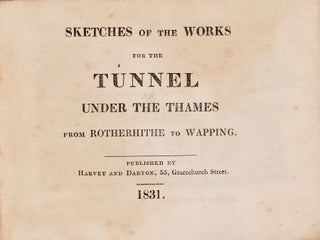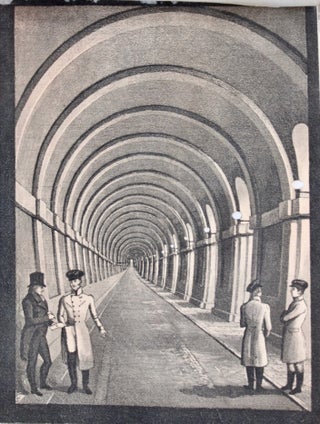Sketches of the Works for the Tunnel, under the Thames, from Rotherhithe to Wapping
[London]: Published by Harvey and Darton, 55, Gracechurch Street, 1831. Marbled Wrappers. Rare issue of this fascinating and fragile pictorial and written record of the first tunnel constructed successfully beneath a navigable river: OCLC records no 1831 edition (but several, dating 1828, '29, and '30), and RBH lists only one copy at auction. Oblong foolscap 8vo (96 x 131mm): 28 unnumbered pages (including title page; some printed one side only as explanations to illustrations), with two steel-engraved plans (one folding, one double-page) and ten plates (two folding, one tinted, one with overlay). Plates by Silvester & Co., Engelmann & Co., M. Dixie, and T. Blood; text printed by the Philanthropic Society, St. George's Fields. Original marbled wrappers, red paper title label to upper cover printed in black. An excellent copy of this fragile production, tightly bound (very skillful restoration to spine; corner of upper cover imperceptibly reattached), text generally clean throughout, some plates with faint unobtrusive water stains. Goldsmiths' 25617. Near Fine+. Item #BB1899
Proposals were being considered in the early 1820s for a tunnel beneath the Thames between Rotherhithe and Wapping, principally to connect the docks under construction on either side of the river's edge. A civil engineer named Marc Isambard Brunel proposed the use of his ingenious self-propelling device, called a "tunnelling shield," to bore the tunnel and was appointed as chief engineer. The first brick was laid on the cast-iron kerb of the Rotherhithe shaft on 2 March 1825, and the shield launched through the shaft wall, 75 feet beneath the river's surface, in December. But the project encountered extraordinary difficulties, "largely on account of the unexpected nature of the geology, which comprised water-bearing sands and gravels where Brunel had expected clay. On several occasions, the river broke into the tunnel, calling for considerable ingenuity and much courage in filling cavities in the river bed by clay and other materials, while restoring damage sustained to the shield. A major irruption on 12 January 1828 led to suspension of the work for more than seven years, the tunnel only half completed and the budget exhausted." (ODNB) The tunnel finally was completed between the two working shafts in December 1841 and opened as a pedestrian tunnel in March 1843. It measures 35 feet wide by 20 feet high and stretched 1,300 feet long. N. B. With few exceptions (always identified), we only stock books in exceptional condition, carefully preserved in archival, removable mylar sleeves. All orders are packaged with care and posted promptly. Satisfaction guaranteed. (Fine Editions Ltd is a member of the Independent Online Booksellers Association, and we subscribe to its codes of ethics.).
Price: $626.00





